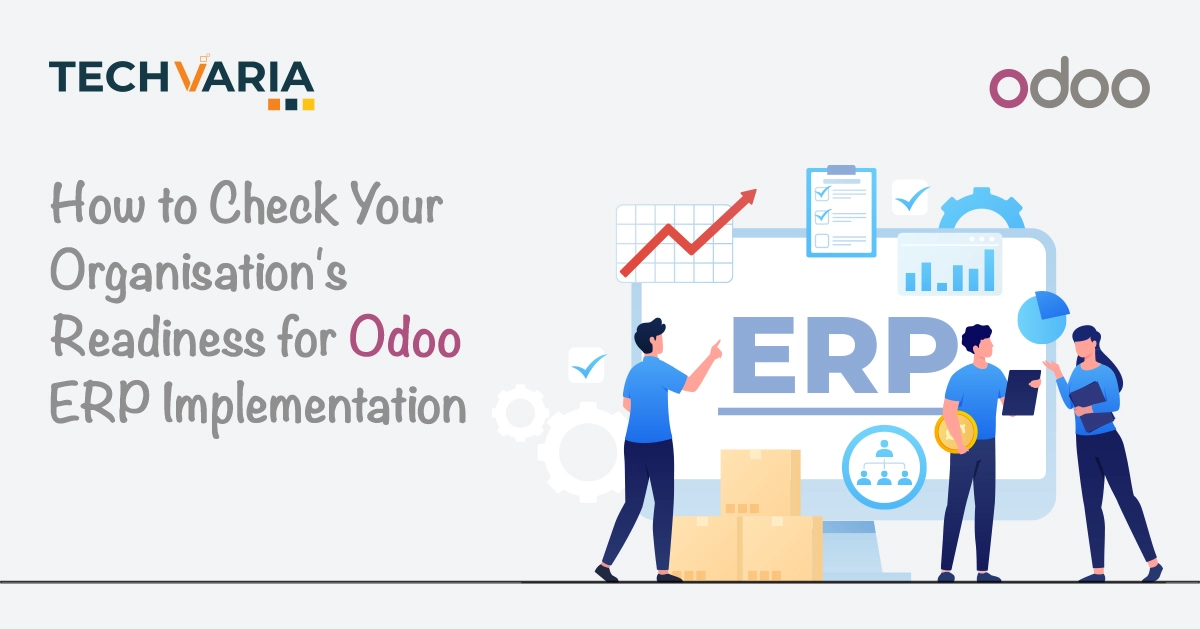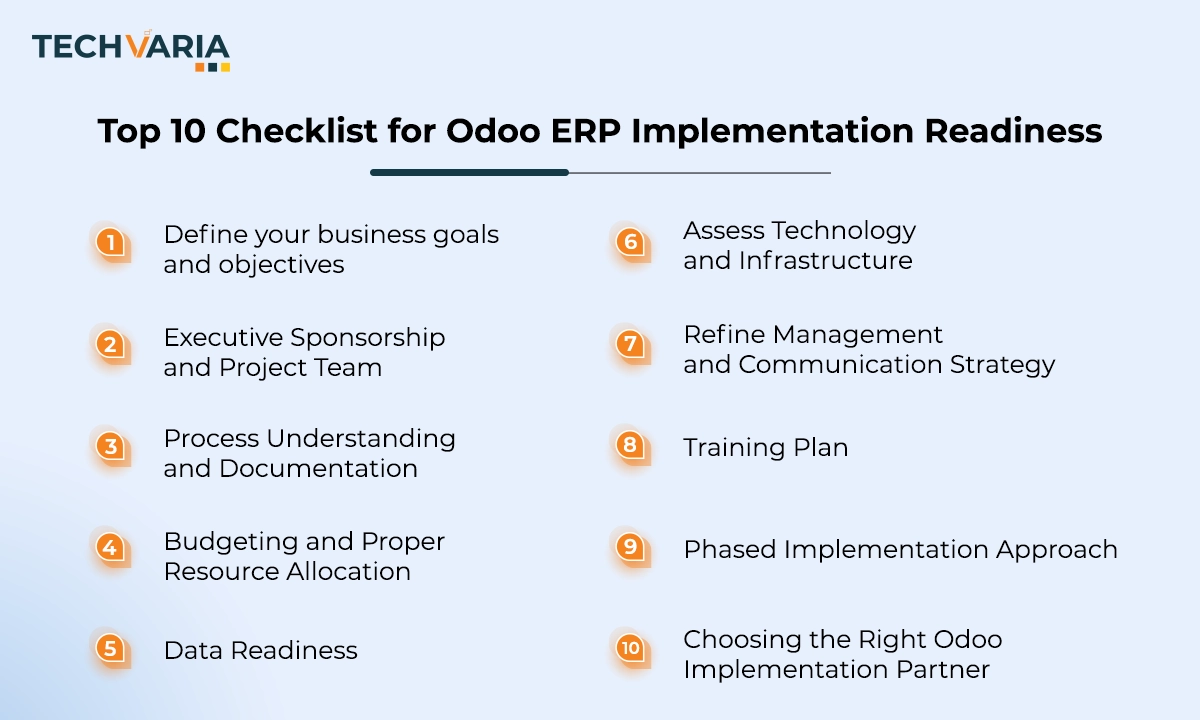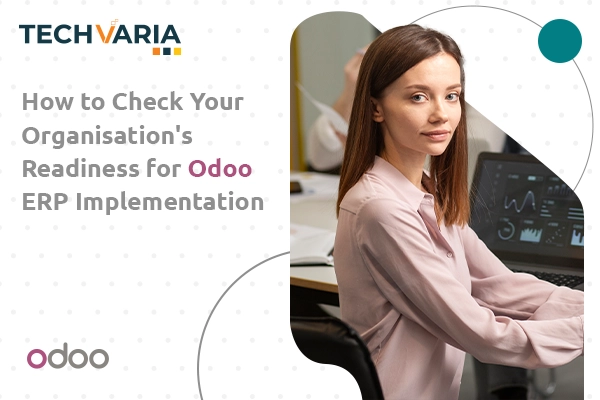How to Check Your Organisation's Readiness for Odoo ERP Implementation

The day you decide to implement Odoo ERP is the day you start your business transformation. In 2025, implementing Odoo ERP is no longer seen as a software decision but as a conscious move to optimise and scale your business.
While intent is important to start this transformation, preparedness is what will assure your success in this growth journey. Therefore, we recommend that before you reach out to a leading Odoo implementation partner or sign a contract with an Odoo implementation service, make sure you are ready. In other words, pause to evaluate every key stage of your operation and your future goals to gauge the readiness of your organisation.
For this phase, we typically suggest that businesses prepare a thorough checklist to understand Odoo ERP implementation readiness. The checklist should focus on every aspect of your current business operations as well as future goals to offer you a clear understanding. At the same time, it must weigh your needs and expectations from ERP implementation and set relevant metrics to compare growth.
Would you like to ensure that your ERP implementation is smooth and effective? Read along to go through our suggested checklist and guide to Odoo implementation for SMEs.
Top 10 Checklist for Odoo ERP Implementation Readiness

Follow this checklist to easily navigate the road to ERP implementation and advance towards your goals without second-guessing your every move.
1. Define your business goals and objectives
This step will act as your north star and keep you on track for your first Odoo project. Hence, your approach in this step should be asking yourself, “why do we need to do this,” and “what do we really want to achieve?”
Once you are clear about the basics, your focus should be on identifying pain points in your daily operations. Typically, businesses that struggle with issues such as disconnected and fragmented departments, slow invoicing, or inventory gaps seek a comprehensive ERP solution. Some SMEs may seek to shorten their production downtime by 2X, quicken their raw materials procurement by 3 days, and improve billing cycles.
So, identify the gaps you want to eliminate and then define a measurable and feasible outcome. For instance, “I want to reduce the sales cycle by 2 weeks or lower carrying cost by 10-12%. ” Remember, your objectives will be clear only if you know how to track success accurately. So, make sure to establish clear ROI metrics before you begin.
However, be wary of setting ambiguous goals such as “improve efficiency” or “speed up production process,” as such targets often leave room for scope creep and unaddressed budget issues.
2. Executive Sponsorship and Project Team
Check where your team stands on ERP implementation and system upgrade. Your focus should be on building strong executive support for continuous momentum and team dedication. This core team’s support will be critical in optimising production workflows.
That’s why you should start by assigning a reliable senior leader or C-level sponsor to initiate the Odoo ERP implementation phase. Next, appoint a project manager and designate super users across departments such as sales, finance, operations, and HR to highlight process gaps and needs.
It is crucial to understand that randomly delegating ERP responsibilities across teams without involving or ensuring executive visibility would not benefit your goals. In fact, it could potentially weaken the team’s accountability.
3. Process Understanding and Documentation
Automation is the present and future of workflow. However, to understand how much it actually benefits you in the end, make sure to document every existing process.
For instance, if you are a manufacturing SME, try to map complex workflows such as production scheduling and quality control cycles. Similarly, if you are a service SME, document your client onboarding and resource allocation processes.
This will help you identify gaps and also help measure results post-implementation. Start with mapping operation workflows such as “turning potential leads to sales,” or “procuring clients to receiving pay.” Next, identify gaps and list the redundant steps that you would like to automate in your business process or at least optimise through Odoo ERP implementation. This will further offer a clear idea of which internal workflows can be aligned with Odoo ERP’s best practices and which can be avoided for customisation.
It is a crucial requirement because undefined or undocumented procedures tend to add complexities during implementation and might reduce efficiency if they are unaccounted for.
4. Budgeting and Proper Resource Allocation
Advanced Odoo implementation for SMEs demands time and strategic financial investment. So, as a business owner, your first step in this phase should be to understand your budget. Depending on your niche, your flow of budget may vary. Typically, manufacturers may need a higher budget for integrating Odoo with production machinery or inventory scanners. On the other hand, retailers may need to invest more in POS system integration.
You must also factor in costs beyond Odoo subscription, such as implementation service charges, data migration expenses, and user training. Chalk out a proper budget and try to set aside a contingency of 10-20% for emergencies. After you have a functional budget, proceed to allocate teams and understand their involvement. Make sure that you don't underestimate internal efforts, as time is a big investment for growing businesses.
5. Data Readiness
Organised data will help ensure your data is smoothly migrated and reported. This will further help with Odoo ERP implementation and operation. To ensure this, make sure to identify critical data sets for your business. Your focus should be on customer data, supplier data, product and inventory data, invoice data, or information most relevant for your business.
For instance, if you are a manufacturer, prioritise organising Bills of Materials and supplier information; but if you run a service firm, make sure to clean project history and contract data. At the same time, audit duplicates and recheck incomplete records. Here, it is important to clean data before you actually begin the transfer.
Take this as a precautionary step that will help eliminate the ‘garbage in, garbage out’ situation. Additionally, unstructured legacy data from several sources tends to cause post-go-live disruptions.
6. Assess Technology and Infrastructure
Next, you should check and assess technology and infrastructure. Accordingly, choose your deployment model—whether Odoo Online (SaaS) or Odoo.sh/On-Premise. Typically, manufacturers opt for On-Premise setups for greater control over their shop floor systems, while service SMEs tend to benefit more from Odoo SaaS to lower IT overhead expenses.
The best way to do this is to verify IT capacity for your On-Premise setups. You can also consider managed cloud hosting but make sure it’s from certified partners. Subsequently, assess your integration needs, whether you want to connect Odoo with e-commerce, CRM, or just payment portals.
Lastly, don't forget to test network speed and server capability because you cannot simply assume your system will work just fine without suitable infrastructure or planning.
7. Refine Management and Communication Strategy
It is important to understand that Odoo ERP will impact you as much as your processes. That’s why it’s important to have an effective change strategy ready which can ensure timely adaptation and lift team morale.
Start with communicating the benefits and purpose of implementation with your employees before you begin the process. If you are met with resistance, highlight how they will benefit and ensure their involvement. Then, establish a communication plan that will break down the rollout stages and new roles or responsibilities.
Ask for feedback so that you understand whether your team members will need hands-on training for new inventory controls, POS changes, or if they understand how project management tools work and upgrade. This is very important because without the team’s support, the workflow will not be successfully optimised.
8. Training Plan
As mentioned, training is crucial to ensure Odoo ERP success and optimisation of workflow processes. That’s why it is important to invest in structured and clear role-based training programs. As a business owner, you must budget for workshops for each implementation phase. The easiest way to approach this is through training by role.
For instance, start with sales teams in CRM modules, finance team in accounting, and service manager in the timesheet and billing module, and if required, cross-train teams. At the same time, focus on building internal training resources for employees to go back and refresh their understanding post-launch.
Some may think that training is not mandatory, as users can learn as they go. This may work in cases where users are already adept with advanced systems and automatic workflow models. Otherwise, it is better to plan workshops and learning sessions for proper system adoption.
9. Phased Implementation Approach
Typically, a phased approach can help lower lingering risks of failed implementation or feature overload. To ensure value realisation, start with high-impact modules such as Sales or CRM before you move on to scaling functions such as Manufacturing, Inventory, or HR.
However, this flow would depend on your area of operation. If you are a manufacturer, then kicking off implementation with inventory management and production planning would make more sense.
Make sure to clearly define the Phase 1 scope to avoid feature overload. Big bang implementation strategy, where businesses try to deploy all apps at once, can overwhelm both teams and budgets.
10. Choosing the Right Odoo Implementation Partner
This is a critical parameter to consider, as your choice of Odoo implementation partner can greatly impact your ERP transformation. To ensure you make an informed choice, check out the Odoo ERP provider’s experience in your industry and request case studies. Check their offerings, pricing models, and customer support after launch.
Here, it is also important to discuss measurable KPIs for better accountability. In our experience, businesses that select partners based entirely on price often end up with a misconfigured system. As a business owner, your focus should be on partnering with a provider who offers quality ERP solutions and support at reasonable rates.
When collaborating with a leading Odoo ERP implementation partner like Techvaria, you do not have to worry about quality and accountability. As a trusted name in the Odoo ERP implementation industry, we bring over 20 years of experience and an extensive case profile.
This equips us with the know-how to cater to the diverse needs of clients from different sectors.
Hence, when you collaborate Techvaria as your Odoo support partner, you gain access to:
- Teams experienced in e-commerce, shop floor integration, and POS.
- Providers who understand complex project workflows.
- Flexible pricing models for different business needs.
- An extensive suite of ERP solutions for various operations.
How to Use the Odoo ERP Readiness Checklist
Use our comprehensive checklist by keeping these in mind:
- Score Your Organisation: Don't forget to rate and colour-code each item. Use Green for items/areas that are ready, Yellow for those that still need to work, or Red to mark things that are not ready.
- Hold a Core Meeting: After a thorough assessment and tally of the checklist, share your findings and ideas with the core leadership team and project stakeholders.
- Create an Action Plan: Your priority should be to address and finish the Yellow-marked items first and then focus on the items marked in red.
Only after you have completed these and turned them into Green will your organisation be ready for Odoo implementation. It is at this step that you should contact Techvaria, your trusted Odoo vendor, and sign the contract.
It is no longer a secret that Odoo ERP can improve operational efficiency for SMEs by a great deal. However, at the end of the day, it is the organisation’s readiness that will actually define the final outcome. That’s why it is important to invest time and resources to prepare your business for a much-needed upgrade and then select the right Odoo implementation service to take your venture to new heights.
As a business owner, remember that a leading Odoo implementation partner will guide your business transformation and allow you to harness ERP’s features to advance your goals.
So, without delay, check your Odoo ERP readiness and get in touch with Techvaria to plan the next step.
Hurry up! We are waiting to hear from you.




